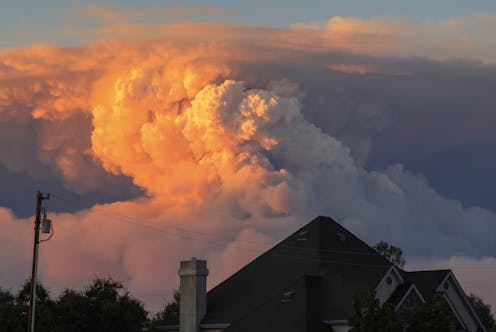Wildfires can create their own weather, further spreading the flames − an atmospheric scientist explains how
- Written by Kyle Hilburn, Research Scientist in Atmospheric Science, Colorado State University

Wildfire blowups[1], fire whirls, towering thunderstorms: When fires get large and hot enough, they can actually create their own weather.
In these extreme fire situations[2], firefighters’ ordinary methods to directly control the fire don’t work, and wildfires burn out of control. Firefighters have seen many of these risks in the enormous Park Fire[3] burning near Chico, California, in summer 2024.
But how can a fire create weather?
What happens next depends on the stability of the atmosphere[8]. If the temperature cools rapidly with elevation above the ground, then the rising air will always be warmer than its surroundings and it will keep rising. If it rises high enough, the moisture will condense, forming a cloud known as a pyrocumulus[9] or flammagenitus.
If the air keeps rising, at some point the condensed moisture will freeze.
Once a cloud has both liquid and frozen water particles, collisions among these particles[10] can lead to electrical charge separation[11]. If the charge buildup is large enough, an electrical discharge – better known as lightning – will occur to neutralize the charges.
Whether a fire-induced cloud will become a thunderstorm depends on three key ingredients[12]: a source of lift, instability and moisture.
Dry lightning
Wildfire environments typically have limited moisture. When conditions in the lower atmosphere are dry, this can lead to what’s known as dry lightning[13].
No one living in a wildfire-prone environment wants to see dry lightning. It occurs when a thunderstorm produces lightning, but the precipitation evaporates before reaching the ground. That means there is no rain to help put out any lightning-sparked fires.
Fire whirls
As air rises in the atmosphere, it may encounter different wind speeds and directions, a condition known as wind shear[14]. This can cause the air to spin. The rising air can tilt the spin to vertical, resembling a tornado[15].
These fire whirls can have powerful winds that can spread flaming ash, sparking new areas of fire. They usually are not true tornadoes, however, because they aren’t associated with rotating thunderstorms.
A time-lapse video shows a large fire whirl during the Park Fire near Chico, Calif., in July 2024.Decaying storms
Eventually, the thunderstorm triggered by the wildfire will begin to die, and what went up will come back down. The downdraft from the decaying thunderstorm can produce erratic winds on the ground[16], further spreading the fire in directions that can be hard to predict.
When fires create their own weather, their behavior can become more unpredictable and erratic, which only amplifies their threat to residents and firefighters battling the blaze. Anticipating changes to fire behavior is important to everyone’s safety.
Satellites show fire-created weather isn’t so rare
Meteorologists recognized the ability of fires to create thunderstorms[17] in the late 1990s. But it wasn’t until the launch of the GOES-R Series[18] satellites in 2017 that scientists had the high-resolution images[19] necessary to see that fire-induced weather is actually commonplace.
Today, these satellites can alert firefighters to a new blaze even before phone calls to 911[20]. That’s important, because there is an increasing trend[21] in the number, size and frequency of wildfires across the United States.
Climate change and rising fire risks
Heat waves and drought risk have been increasing in North America[22], with rising global temperatures more frequently leaving dry landscapes and forests primed to burn. And climate model experiments indicate that human-caused climate change will continue to raise that risk[23].
As more people move into fire-risk areas in this warming climate, the risk of fires starting[24] is also rising. With fires come cascading hazards[25] that persist long after the fire is out, such as burn-scarred landscapes that are much more susceptible to landslides[26] and debris flows that can affect water quality and ecosystems.
Communities can reduce their vulnerability to fire damage[27] by building defensible spaces and firebreaks and making homes and property less vulnerable[28]. Firefighters can also reduce the surrounding fuel loads with prescribed fire.
It’s important to remember that fire is a natural part of the Earth system. As fire scientist Stephen J. Pyne[29] writes, we as humans will have to reorient our relationship with fire so we can learn to live with fire.
References
- ^ blowups (inciweb.wildfire.gov)
- ^ extreme fire situations (doi.org)
- ^ enormous Park Fire (inciweb.wildfire.gov)
- ^ atmospheric scientist (scholar.google.com)
- ^ weather prediction models (doi.org)
- ^ wildfires create their own wind patterns (doi.org)
- ^ Adam Kochanski/San Jose State University/WIRC (home.chpc.utah.edu)
- ^ stability of the atmosphere (www.rmets.org)
- ^ forming a cloud known as a pyrocumulus (doi.org)
- ^ collisions among these particles (doi.org)
- ^ electrical charge separation (doi.org)
- ^ three key ingredients (doi.org)
- ^ dry lightning (www.firelab.org)
- ^ wind shear (theconversation.com)
- ^ resembling a tornado (doi.org)
- ^ erratic winds on the ground (www.iawfonline.org)
- ^ ability of fires to create thunderstorms (doi.org)
- ^ GOES-R Series (doi.org)
- ^ high-resolution images (rammb-slider.cira.colostate.edu)
- ^ even before phone calls to 911 (www.usda.gov)
- ^ increasing trend (doi.org)
- ^ increasing in North America (doi.org)
- ^ human-caused climate change will continue to raise that risk (doi.org)
- ^ risk of fires starting (doi.org)
- ^ cascading hazards (doi.org)
- ^ much more susceptible to landslides (theconversation.com)
- ^ vulnerability to fire damage (www.ready.gov)
- ^ making homes and property less vulnerable (theconversation.com)
- ^ Stephen J. Pyne (www.ucpress.edu)
Authors: Kyle Hilburn, Research Scientist in Atmospheric Science, Colorado State University

